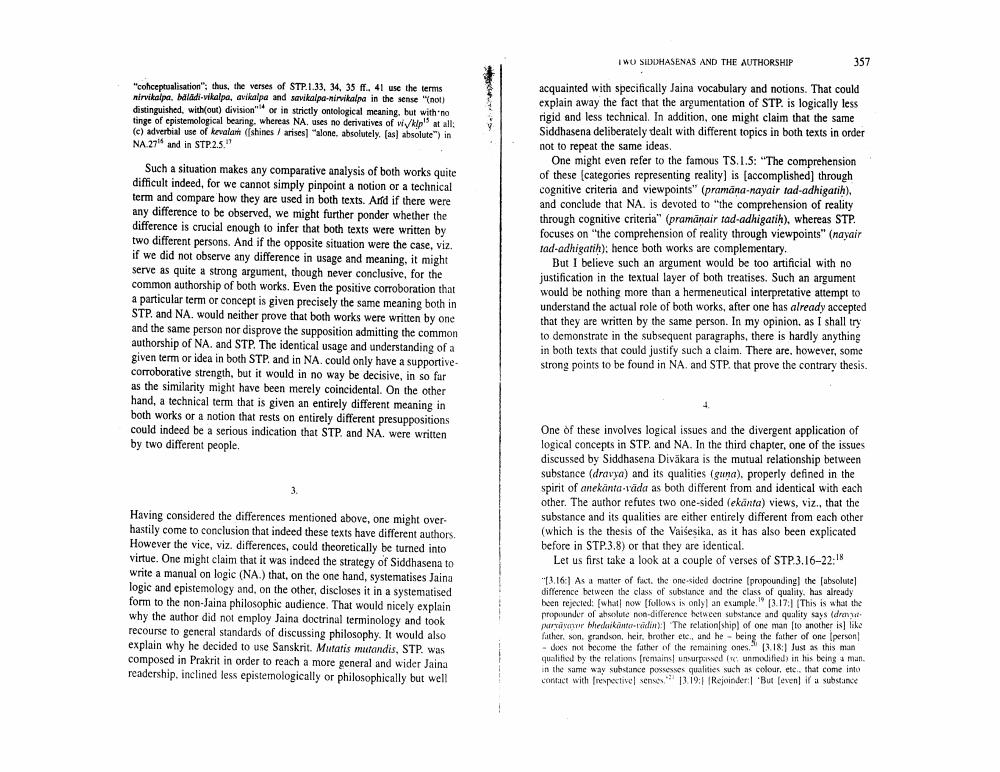Book Title: Two Siddhasenas And Authorship Of Nyayavatara And Sammati Tarka Pprakarana Author(s): Piotr Balcerowicz Publisher: Piotr Balcerowicz View full book textPage 4
________________ IWU SIDDHASENAS AND THE AUTHORSHIP 357 "cohceptualisation"thus, the verses of STP.1.33, 34, 35 f. 41 use the terms nirvikalpa, hladi-vikalpa, avikalpa and servikalpa-nirvikalpa in the sense "not) distinguished without) division or in strictly ontological meaning, but with no tinge of cpistemological bearing, whereas NA. uses no derivatives of wikip at all: (c) adverbial use of krvalam (shines / arises alone. absolutely (as) absolute) in NA 27" and in STP.2.5. Such a situation makes any comparative analysis of both works quite difficult indeed, for we cannot simply pinpoint a notion or a technical term and compare how they are used in both texts. Arld if there were any difference to be observed, we might further ponder whether the difference is crucial enough to infer that both texts were written by two different persons. And if the opposite situation were the case, viz. if we did not observe any difference in usage and meaning, it might serve as quite a strong argument, though never conclusive, for the common authorship of both works. Even the positive corroboration that a particular term or concept is given precisely the same meaning both in STP. and NA. would neither prove that both works were written by one and the same person nor disprove the supposition admitting the common authorship of NA. and STP. The identical usage and understanding of a given term or idea in both STP. and in NA. could only have a supportive corroborative strength, but it would in no way be decisive, in so far as the similarity might have been merely coincidental. On the other hand, a technical term that is given an entirely different meaning in both works or a notion that rests on entirely different presuppositions could indeed be a serious indication that STP. and NA. were written by two different people. acquainted with specifically Jaina vocabulary and notions. That could explain away the fact that the argumentation of STP. is logically less rigid and less technical. In addition, one might claim that the same Siddhasena deliberately dealt with different topics in both texts in order not to repeat the same ideas. One might even refer to the famous TS.1.5: "The comprehension of these categories representing reality) is (accomplished) through ognitive criteria and viewpoints" (pramāna-nayair tad-adhigarih). and conclude that NA. is devoted to the comprehension of reality through cognitive criteria" (pramanair tad-adhigarih), whereas STP. focuses on the comprehension of reality through viewpoints" (nayair tad-adhigari): hence both works are complementary. But I believe such an argument would be too artificial with no justification in the textual layer of both treatises. Such an argument would be nothing more than a hermeneutical interpretative attempt to understand the actual role of both works, after one has already accepted that they are written by the same person. In my opinion, as I shall try to demonstrate in the subsequent paragraphs, there is hardly anything in both texts that could justify such a claim. There are, however, some strong points to be found in NA. and STP. that prove the contrary thesis. Having considered the differences mentioned above, one might over hastily come to conclusion that indeed these texts have different authors. However the vice, viz. differences, could theoretically be turned into virtue. One might claim that it was indeed the strategy of Siddhasena to write a manual on logic (NA.) that, on the one hand, systematises Jaina logic and epistemology and, on the other, discloses it in a systematised form to the non-Jaina philosophic audience. That would nicely explain why the author did not employ Jaina doctrinal terminology and took recourse to general standards of discussing philosophy. It would also explain why he decided to use Sanskrit. Mutatis mutandis, STP. was composed in Prakrit in order to reach a more general and wider Jaina readership, inclined less epistemologically or philosophically but well One of these involves logical issues and the divergent application of logical concepts in STP. and NA. In the third chapter, one of the issues discussed by Siddhasena Divakara is the mutual relationship between substance (dravya) and its qualities (guna), properly defined in the spirit of anekanta.Tāda as both different from and identical with each other. The author refutes two one-sided (ekārta) views, viz., that the substance and its qualities are either entirely different from each other (which is the thesis of the Vaisesika, as it has also been explicated before in STP.3.8) or that they are identical. Let us first take a look at a couple of verses of STP.3.16-22: 13.16] As a matter of fact, the one sided doctrine (propounding the absolute] difference between the class of substance and the class of quality, has already been rejected: [what now (follows is only an example 13.17:1 (This is what the propunder of a lute non-difference between substance and quality says (dra Jerner Wecantici: 'The relationship of one man [to another is like father, son grandson, heit, brother ete, and he - being the father of one person - does not become the father of the remaining ones. 13.18. Just as this man qualified by the relations (remains pod enmodified in his being a man in the same way substance possesses qualities such as colour, etc. that come into contact with respectivel sense 13.19: Rejoinder: 'But leven if a substance ce posunurpornoPage Navigation
1 2 3 4 5 6 7 8 9 10 11 12 13 14
